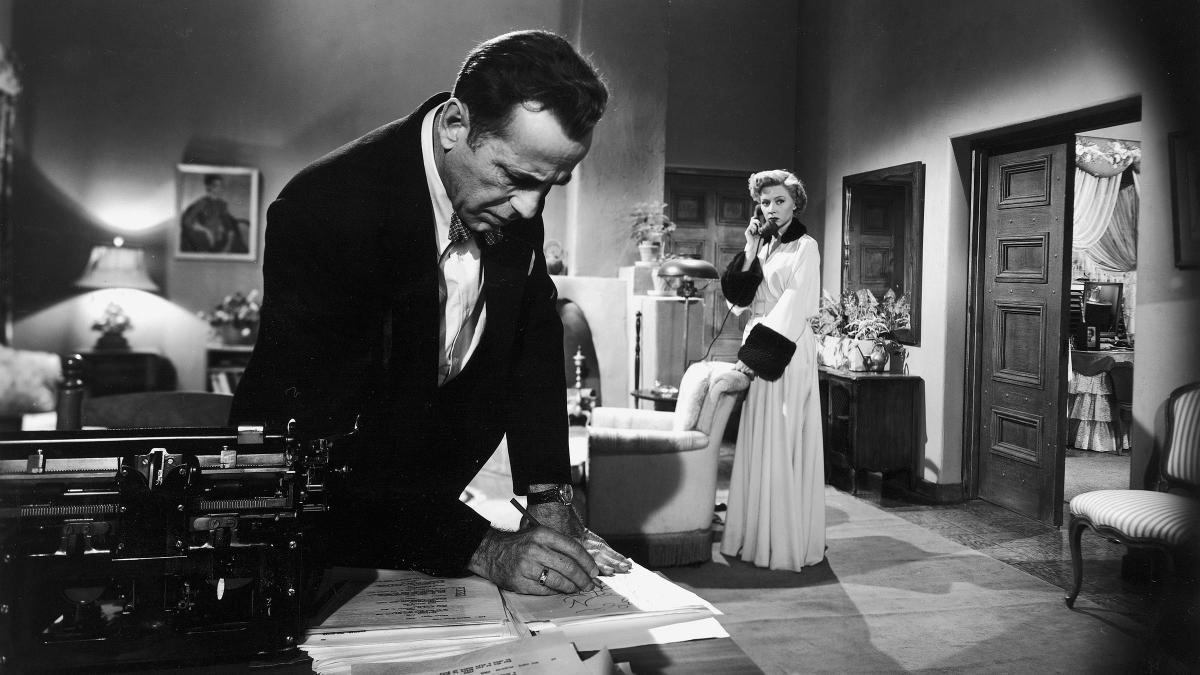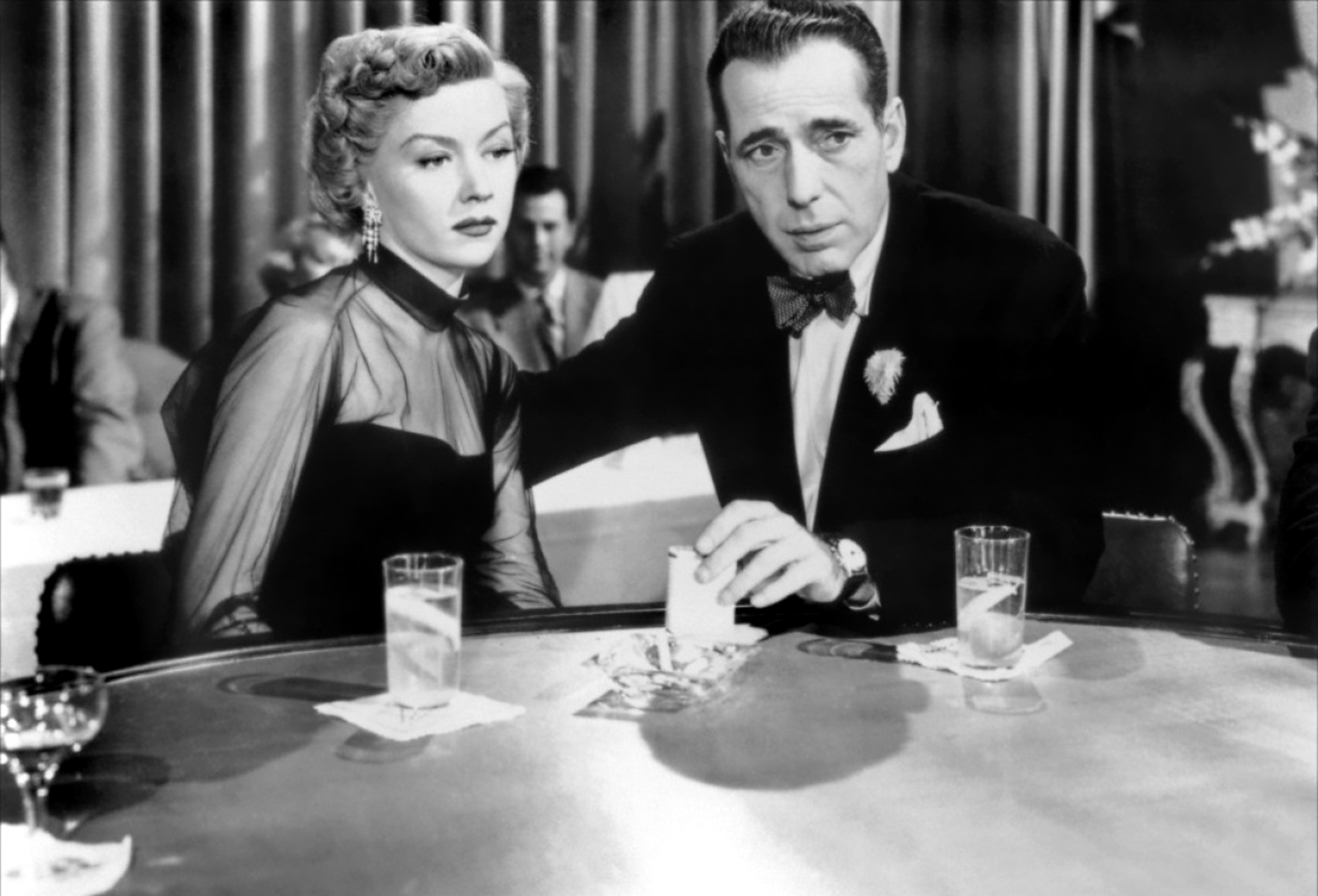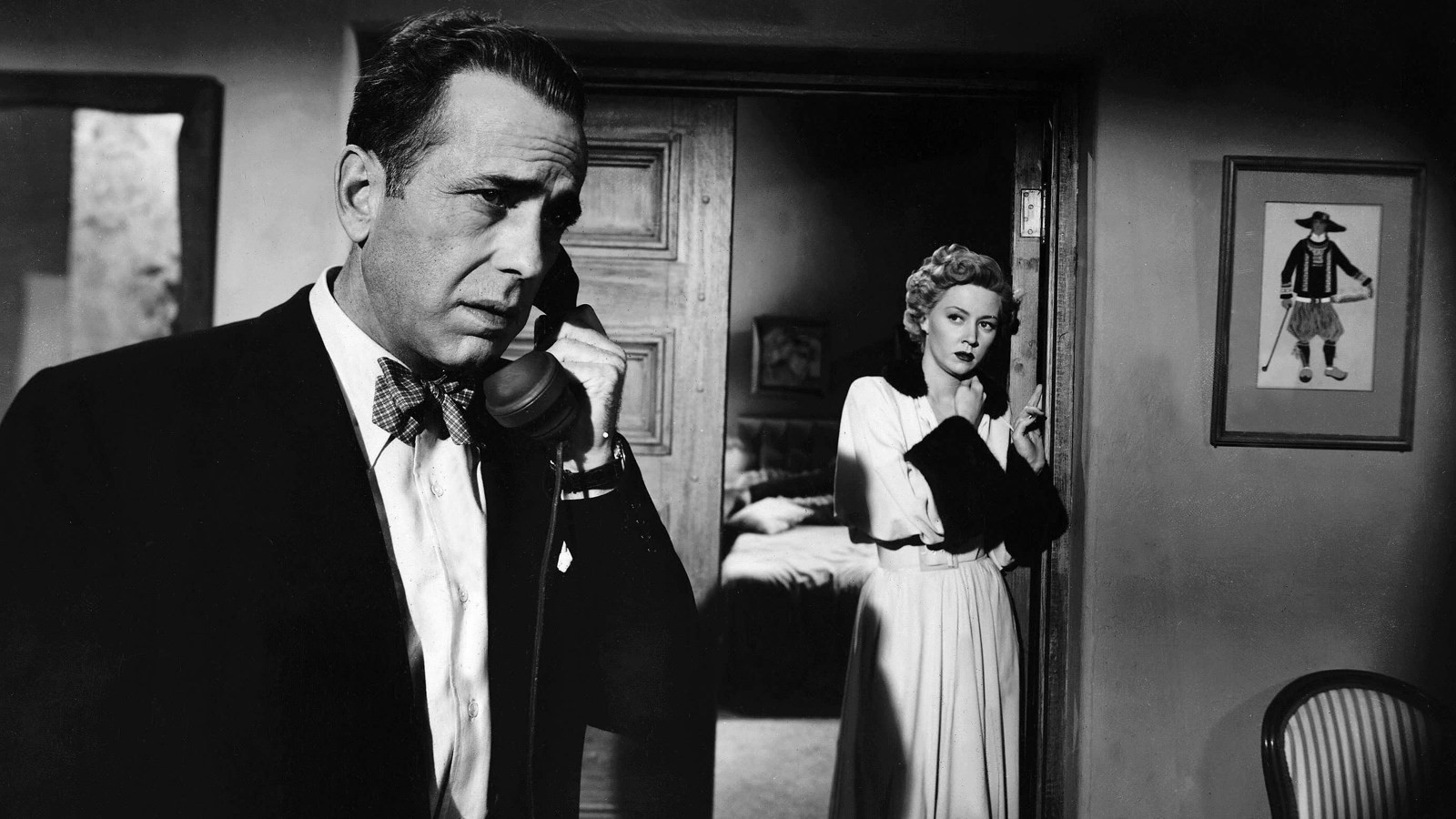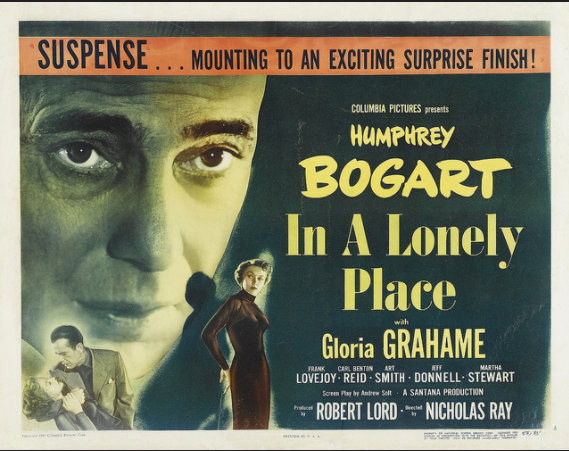In a Lonely Place, Nicholas Ray’s imperishable classic of doomed romance, has always stood apart from the rest of the film noir pack. A film concerned less with the trademark narrative convolutions of noir and more with the dark passions and moral failings of its central characters, the richness and complexity of this bittersweet masterpiece was heavily informed by the psychological baggage carried onto the set by each of the primary players. With director Ray and star Gloria Grahame going through a spectacularly messy marriage break-up just as the cameras rolled, the strong whiff of scandal wafting from behind the scenes provided a perfect example of life’s uncanny ability to imitate art; it’s difficult to recall another movie of its era in which the events enacted onscreen mirrored with such sublime irony the torrid psychodrama unfolding behind the cameras.
By the time he commenced work on In a Lonely Place the 38-year old Ray had already caught the eye with his blistering debut They Live By Night (1948), a thematic forerunner to both Joseph H. Lewis’ B-classic Gun Crazy (1950) and Arthur Penn’s era-defining Bonnie and Clyde (1967). He worked with Humphrey Bogart for the first time on Knock On any Door (1949) before embarking on an adaptation of Dorothy B. Hughes crime novel In a Lonely Place – a lurid tale of an investigation into the crimes of a serial killer in post-WW2 Los Angeles. Ray and screenwriter Edmund North, determined to tell a very different tale, deviated entirely from the source novel’s hackneyed whodunit narrative. The resulting script was infused with all the fatalistic poetry of classic noir, holding out the possibility of happiness for its central characters just long enough to make it all the more wrenching when their plans are thwarted by implacable fate.
As a film-maker, Ray instinctively empathised with his characters – invariably disaffected outsiders fighting to retain their sanity amidst the often stifling conformity of post-war American society. Rather than the classic private eye/femme fatale dynamic familiar from countless noirs, In a Lonely Place instead shows us two deeply flawed individuals who both long for a meaningful connection, but instead find themselves swimming against the rough tides of destiny and human frailty.

Humphrey Bogart’s Dix Steele is a brawling Hemingway-esque alpha-screenwriter who masks his fragile ego and insecurities in archetypal boozy machismo. Quick to lose his temper, he has an undisguised contempt for the movie industry in which he’s become an underused cog. Rumours of past crimes cast a grim shadow over Dix, but despite his myriad faults he also displays a weather-beaten nobility – contrasting sharply with the avarice and vulgarity of the oily money men and “popcorn salesmen” with whom he regularly butts heads. Ray shared with his lead character an iconoclast’s distaste for the Hollywood machine, and allows us to glimpse an engaging humanity behind Dix’s bluff exterior.
Upon meeting the elegant, struggling actress Laurel Gray (Gloria Grahame), he senses a deep connection with a fellow lost soul. Soon they embark on an intense affair, but inevitably, as the film’s murder-mystery sub-plot plays out, the two lovers are forced apart as the fates conspire to drive a wedge between them. As Dix begins to crack under the weight of a dogged police captain’s suspicions, and Laurel becomes increasingly fearful of his irrational outbursts, their relationship is slowly, and fatally, poisoned. The film’s most memorable phrase, pitched by Dix to Laurel as a possible line in a script he is working on – “I was born when she kissed me, I died when she left me, I lived a few weeks while she loved me” – becomes a tragic premonition of their love’s demise. When Dix asks Laurel to repeat his words, it seems to seal a strange bond made sacred by an aching foreknowledge of the end of their affair.

The pairing of Grahame and Bogart in In A Lonely Place was serendipitous; Lauren Bacall had originally been lined up to again partner her husband on screen, but contractual obligations stymied the prospect. However, as undeniably great as Bacall and Bogart were in wise-cracking back-and-forth mode, Grahame had a broader emotional range as an actress, allowing her to exhibit a complex mix of vulnerability and polished worldliness which gives her performance a genuinely poignant dimension, one which contrasts perfectly with Bogart’s edgy magnetism. In one memorable scene, when they sit close together in the smoke-wreathed surrounds of an intimate club – while the great jazz pianist Hadda Brooks croons “I Hadn’t Anyone ‘Til You” – their heady chemistry is something to behold.
Bogart’s performance as Dix is the film’s engine, and it’s one of his finest. Ray’s clever lighting and framing often make Dix resemble a feral predator ready to pounce on his prey, as those dark eyes glint with menace after some perceived slight pushes him to the brink. Bogart has the skill and charisma to seduce the viewer, but also to keep us questioning whether Dix really could be a remorseless killer, accomplished in the art of hiding in plain sight. Bogart’s iconic ‘40s private eye turns as Sam Spade and Philip Marlowe were relatively uncomplicated in their lack of ambiguity; possessed of boundless self-belief, those characters always had a way out of every dark corner. By contrast Dix Steele is a much more insecure proposition, riven with self-loathing and paranoia, and prone to lashing out violently as his irrational nature causes him to sense betrayal around every corner.
Offscreen, like Dix and Laurel, director Ray and star Grahame’s relationship was always fated to derail at high speed. After a shotgun wedding when Grahame was revealed to be pregnant in 1948, the union between these two extremely volatile and impulsive personalities was soon headed for very stormy weather. Both parties boozed and drugged heavily, and roof-raising arguments between the pair became frequent. When Grahame was eventually found in bed with Ray’s teenage son from another marriage, she could scarcely have picked a more hair-raisingly reckless way to put the kibosh on this unholy alliance.

Details of the filming contract which Ray forced on his erstwhile wife during all this tumult would be comical if they weren’t so pathetic; among other draconian stipulations it expressly decreed that Grahame should obey Ray’s instructions at all times during filming, and “in every conceivable situation his will and judgment shall be considered superior to (Grahame’s) and shall prevail”. While it’s easy to conclude that only a shamefully spiteful heel would impose so many ludicrous restrictions, Grahame certainly had enough form in the ball-busting department to explain how she may have managed to provoke such risible pettiness from the highly-strung Ray. After winning an Oscar in 1953 for The Bad and the Beautiful, Grahame’s career faded in the 60s and 70s; the recent release Film Stars Don’t Die in Liverpool casts light on a little-known episode in Grahame’s career when she travelled throughout the UK as a jobbing actress in the late 1970’s, again demonstrating her predilection for much younger men by shacking up with the twenty-something Peter Turner. Annette Bening is already generating Oscar buzz for her performance as an ageing but still glamorous Grahame, with Jamie Bell as the young Liverpudlian besotted with the fading star of Old Hollywood.
After his expert helming of In a Lonely Place, the extravagantly gifted wild-man Ray would go on to direct a string of blazingly colourful, no-holds-barred classics throughout the ’50s, among them the hot-under-the-collar rodeo drama The Lusty Men (1952), bonkers camp western Johnny Guitar (1954) with Joan Crawford, and turned-up-to-11 suburban shocker Bigger than Life (1956). Along the way he also casually tossed a grenade onto the sidewalk of white picket-fence America by unleashing a muttering, white t-shirted James Dean on straight 50s society in Rebel Without a Cause (1955).
Sidelined by Hollywood in the 60s, Ray concentrated on several small-scale experimental projects before eventually reinventing himself in the 70s as a dope-smoking guru at Binghamton University, schooling the kids in avant-garde techniques. He died in 1979, his reputation as a one-off Hollywood maverick well and truly secure. Looking back at his highly eventful career, it’s possible that In a Lonely Place, produced amid an atmosphere of such rancour and turmoil, is his crowning glory. Do yourself a favour and go see it this week; forged in the crucible of crazed and uncontrollable real-life passions, it’s film noir at its most seductive, poetic and sweetly tragic.
Scannain caught up with Barbara Broccoli, producer of Film Stars Don’t Die in Liverpool, recently to talk about Gloria Grahame and her legacy.

